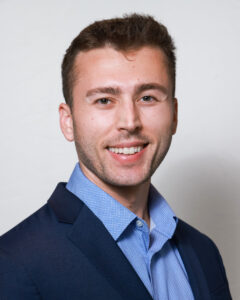Researcher Highlight: Payton Stone

Payton Stone, 4th year Chemical Engineering Ph.D. Candidate in the Wilson Lab
Summary of Research:
Peptides, proteins, and nucleic acids make up many of the recently developed cancer immunotherapies, which function by activating intracellular pathways to elicit downstream signaling cascades, which in turn result in robust anticancer immune responses. However, the clinical success and efficacy of these therapeutics is hindered by their poor pharmacological properties, which include rapid clearance from the blood, susceptibility to nuclease degradation, and the inability to freely cross the cellular membrane to activate these cytosolic pathways. My work seeks to overcome these clinical barriers by (1) developing a high-throughput platform to produce therapeutic-loaded polymeric nanoparticles, (2) assessing the ability of the system to elicit an antitumor immune response and prolong survival in murine cancer models, and (3) engineering the drug-loaded nanoparticles to target specific cells in the tumor microenvironment (TME).
The limitations to intracellular delivery have been a major obstacle in the success of many cancer immunotherapies. Much of the work in the field has been focused on the development of various ‘smart’ nanocarriers to improve the pharmacokinetic behavior and enhance the cytosolic delivery of these drugs. My work uses pH-responsive polymeric nanocarriers that can be endocytosed through the cell membrane and disassemble in response to a decrease in pH within the endosome, allowing for the cytosolic release of the drug cargo. By assessing structure-function relationships, we seek to optimize the nanocarrier for intravenous delivery applications and evaluate therapeutic efficacy in cancer models.
With intravenous delivery, one of the major concerns is off-target toxicity and overwhelming immune responses, known as ‘cytokine storm’. By functionalizing protein fragments, known as nanobodies, onto the surface of the nanocarrier, we can improve the biodistribution of the system by targeting specific immunosuppressive cells at the tumor site. Ultimately, our interdisciplinary approach integrates polymer chemistry, nanoparticle fabrication, and protein engineering to develop and optimize a novel platform that can circumnavigate many of the previous barriers to intracellular delivery and clinical success.
My Graduate School Journey:
Like most of my fellow classmates, moving to a new city and beginning my graduate studies in August 2020 presented a lot of challenges. The pandemic caused all my first-year classes to be completely virtual, and most on-campus activities were extremely limited. As a result, much of my first year of graduate school involved adapting to an entirely new way of learning and developing as a scientist.
In the summer of my first year of graduate school, I served as a co-mentor for an undergraduate student as part of the VINSE-REU program. With the help of VINSE and its provided resources, I was able to witness firsthand as his scientific knowledge and presentation skills developed over the course of the program. I so much enjoyed my mentorship experience with VINSE-REU, that I decided to co-mentor another undergraduate student my second summer of graduate school, as well. The hard work displayed by both students has provided them with co-authorship on a recent publication to Nanoscale submitted by our lab.
Ultimately, VINSE has played an exemplary role in my graduate studies. During my time at Vanderbilt, I have been fortunate enough to be able to present my research at five institutional conferences and three national conferences, and I have received NIH T32 and NSF-GRFP fellowships. Most importantly though, I have found a sense of belonging within my lab and the Vanderbilt community, and I am so honored to be a part of all the cutting-edge research being conducted at this school. With the resources, equipment, and developmental programs provided by VINSE, I have been able to witness myself and others develop as researchers, and I am excited to continue to collaborate with this program in the future.
Contact: Payton Stone
